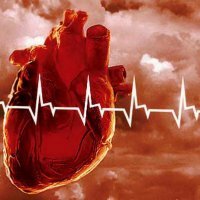Stenosis of the left atrioventricular orifice

The left atrioventricular aperture normally has an area of 4-6 cm2, which correlates with the total surface area of the body. The narrowing of the lumen of the left atrioventricular orifice causes difficulties in expelling blood to the left ventricle from the left atrium. In turn, this leads to an increase in blood pressure in the left atrium to 20-25 mm mercury. Art. And reflex spasm of pulmonary arterioles. As a consequence, the inflow of blood to the left atrium decreases. Such a pathology is called stenosis of the left atrioventricular aperture or metral stenosis.
Symptoms of
In the case of a slight decrease in the left atrioventricular orifice, hemodynamics is maintained in norm by additional efforts in the operation of the left atrium. In this situation, patients may not experience any discomfort. Further decrease in the lumen of the opening, increase in pressure in the small circle of blood pressure leads to shortness of breath. It was found that the intensity of dyspnea correlates with the degree of narrowing of the mitral valve. In addition, concomitant symptoms are attacks of cardiac asthma, weakness, dry cough or cough with sputum, in which blood veins, palpitations, increased fatigue with little physical exertion, and sometimes pain in the heart region are found.
Treatment of
The method of treatment of narrowing of the left atrioventricular orifice depends on the severity of the patient's condition, degree of hemodynamic disorder, and the stage of development of pathology.
So, for example, at the I stage the patient is not shown the operation. It was found that the operation at stage II is most effective, since it prevents the progression of pathology. At this stage, a closed commissurotomy or catheter balloon valvuloplasty is performed. At stage III, surgical treatment is considered necessary, despite the fact that the timing has already been delayed and the time of the effective operation has been missed. At this stage of pathology, therapy with medicinal products gives only a temporary beneficial effect. At stage IV, surgery is possible, but the risk of an adverse outcome is greatly increased. Therapy with drugs at this stage has a small effect. At stage V, this pathology is treated only symptomatically.
In the case when the expressed fibrous changes of valves and calcification of the valve are absent, patients with sinus rhythm pathology perform an operation in the form of closed mitral commissurotomy. With the tool( dilator or commissurotom) or a finger, separate the adhesions and eliminate the subclaved fusion.
In the case of left-sided access to the cardiac muscle, the finger is inserted through the eye of the left atrium by applying a suturing suture at its base. If necessary, a dilator is inserted into the left ventricle to expand the mitral opening. Such manipulation is performed on the avascular region of its apex.
In the case of right-hand access, the instrument or finger is inserted through the interatrial fissure. When a thrombus or calcification of the valve is detected at the time of the operation in the left atrium, or if an attempt to close the commissurotomy becomes ineffective, or if the dilatation of the mitral orifice leads to a valve failure, then an open valve correction is performed with artificial circulation. If the valve changes are clearly expressed due to calcification and regurgitation, then proceed to prosthetics.
A plastic operation of the left atrioventricular valve is done on the open heart with the use of cardioplegia methods. Such an operation is aimed at restoring the subvalves and the structure of the flaps. With calcification of the valve and its regurgitation, prosthetics is prescribed.
The effectiveness of commissurosotomy is highest in stages II and III, when changes in the internal organs caused by disorders in the circulatory system are still reversible.
Patients who underwent surgery should be supervised by a rheumatologist. They are given seasonal antirheumatic therapy against exacerbation of the process, failure of the valve or restenosis. Since when they appear, there is a need for a re-operation.



